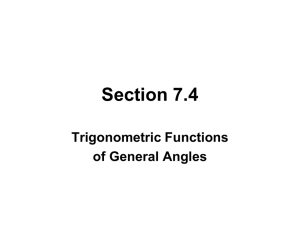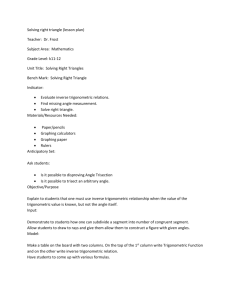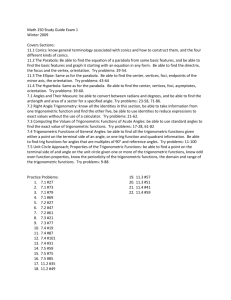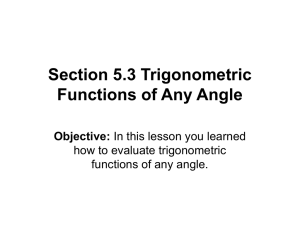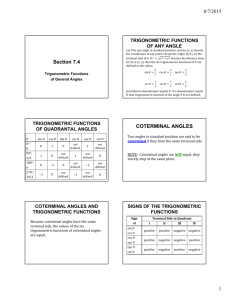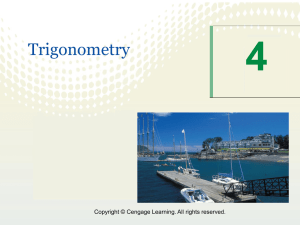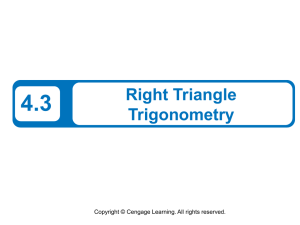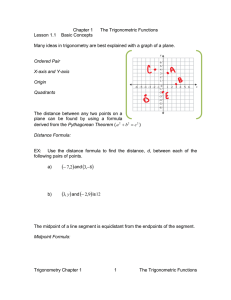Trigonometric Functions of Acute Angles
advertisement
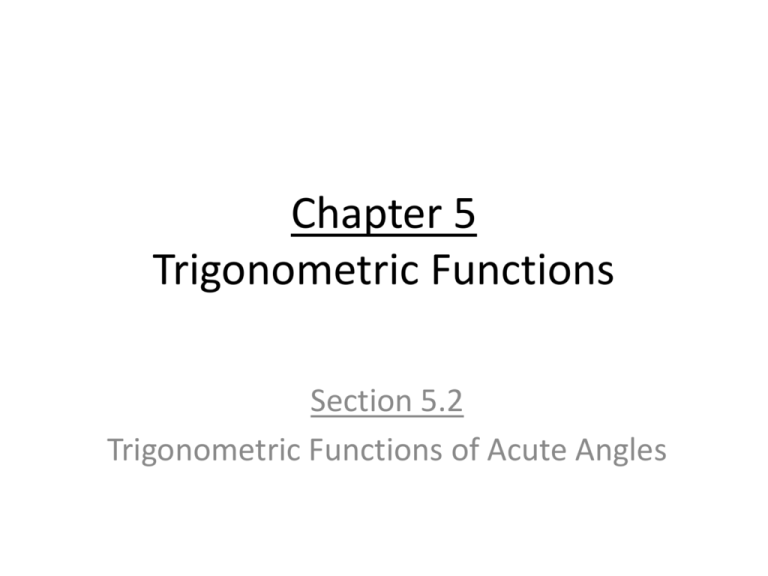
Chapter 5 Trigonometric Functions Section 5.2 Trigonometric Functions of Acute Angles Trigonometric Functions of Acute Angles When working with right triangles, it is convenient to refer to the side opposite an angle or the side adjacent to (next to) an angle. Trigonometric Functions of Acute Angles Consider an angle q in the right triangle shown below. Let x and y represent the lengths, respectively, of the adjacent and opposite side of the triangle, and let r be the length of the hypotenuse. Six possible ratios can be formed: 𝑦 𝑟 𝑥 𝑟 𝑦 𝑥 𝑟 𝑦 𝑟 𝑥 𝑥 𝑦 Trigonometric Functions of Acute Angles sin q = 𝑜𝑝𝑝𝑜𝑠𝑖𝑡𝑒 ℎ𝑦𝑝𝑜𝑡𝑒𝑛𝑢𝑠𝑒 cos q = 𝑎𝑑𝑗𝑎𝑐𝑒𝑛𝑡 ℎ𝑦𝑝𝑜𝑡𝑒𝑛𝑢𝑠𝑒 tan q = 𝑜𝑝𝑝𝑜𝑠𝑖𝑡𝑒 𝑎𝑑𝑗𝑎𝑐𝑒𝑛𝑡 csc q = ℎ𝑦𝑝𝑜𝑡𝑒𝑛𝑢𝑠𝑒 𝑜𝑝𝑝𝑜𝑠𝑖𝑡𝑒 sec q = ℎ𝑦𝑝𝑜𝑡𝑒𝑛𝑢𝑠𝑒 𝑎𝑑𝑗𝑎𝑐𝑒𝑛𝑡 cot q = 𝑎𝑑𝑗𝑎𝑐𝑒𝑛𝑡 𝑜𝑝𝑝𝑜𝑠𝑖𝑡𝑒 Trigonometric Functions of Acute Angles Example 1 Find the six trigonometric functions of q for the triangle given in the Figure 5.32 below. Example 2 Given that q is and acute angle and 5 8 cos q = , find tan q. Trigonometric Functions of Special Angles Special Angles Trigonometric Functions of Special Angles Example Find the exact value of sin2450 + cos2600. Reciprocal Functions sin q = 1 csc θ tan q = 1 cot θ csc q = 1 sin θ cos q = 1 sec θ sec q = 1 cos θ cot q = 1 tan θ Applications From a point 115 feet from the base of a redwood tree, the angle of elevation to the top of the tree is 64.30. Find the height of the tree to the nearest foot. Applications If the distance from a plane to a radar station is 160 miles and the angle of depression is 330, find the number of ground miles from a point directly below the plan to the radar station. Applications The angle of elevation from point A to the top of a space shuttle is 27.20. From a point 17.5 meters further from the space shuttle, the angle of elevation is 23.90. Find the height of the space shuttle. Assignment Section 5.2 - Worksheet

